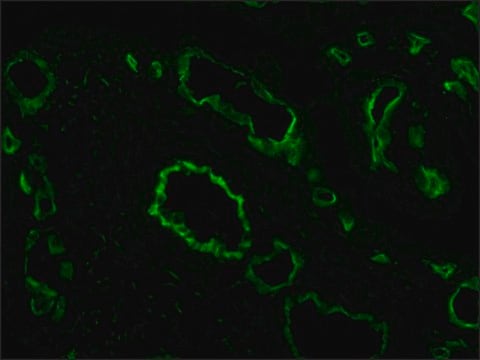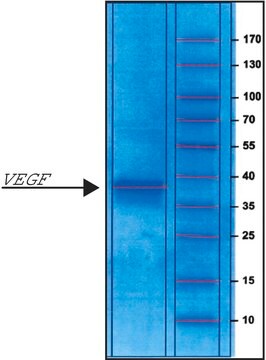ECM002
Thrombospondin-1 human
recombinant, expressed in HEK 293 cells, lyophilized powder, suitable for cell culture
Synonyme(s) :
THBS, THBS1, TSP, TSP1, Thrombospondin-1
About This Item
Produits recommandés
Source biologique
human
Niveau de qualité
Produit recombinant
expressed in HEK 293 cells
Stérilité
sterile
Pureté
≥95% (SDS-PAGE)
Forme
lyophilized powder
Poids mol.
127.5 kDa (The protein migrates as a 140 kDa band on SDS-PAGE due to glycosylation.)
Conditionnement
pkg of 50 μg
Technique(s)
cell culture | mammalian: suitable
Impuretés
≤1 EU/μg endotoxin, tested
Solubilité
water: soluble
Numéro d'accès NCBI
Numéro d'accès UniProt
Conditions d'expédition
dry ice
Température de stockage
−20°C
Informations sur le gène
human ... THBS1(7057)
Description générale
Application
- To treat hepatocyte (IHH) cancer cells to study the role of aspartyl protease 1 (MfSAP1) in extracellular matrix degradation.
- In in vitro Extracellular Matrix (ECM) protein degradation assays.
- In rat C6 astroglioma cells, for coating the cell culture plates to study the effects of integrins on CNTF (ciliary neurotrophic factor) expression.
- In the preparation of secreted factor cocktail for analysis of the human mesenchymal stem cell secretome.
Recommended for use as a cell culture substratum at 1-5 μg/cm2 or 0.1-25 μg/ml. Optimal concentration depends on cell type as well as the application or research objectives.
Actions biochimiques/physiologiques
Caractéristiques et avantages
- Human-derived thrombospondin
- Produced through recombinant expression in HEK 293 cells
- Low endotoxin levels
Forme physique
Remarque sur l'analyse
Code de la classe de stockage
11 - Combustible Solids
Classe de danger pour l'eau (WGK)
WGK 2
Point d'éclair (°F)
Not applicable
Point d'éclair (°C)
Not applicable
Certificats d'analyse (COA)
Recherchez un Certificats d'analyse (COA) en saisissant le numéro de lot du produit. Les numéros de lot figurent sur l'étiquette du produit après les mots "Lot" ou "Batch".
Déjà en possession de ce produit ?
Retrouvez la documentation relative aux produits que vous avez récemment achetés dans la Bibliothèque de documents.
Articles
Attachment Factors for 3-Dimensional Cell Culture
The extracellular matrix (ECM) is secreted by cells and surrounds them in tissues.
Notre équipe de scientifiques dispose d'une expérience dans tous les secteurs de la recherche, notamment en sciences de la vie, science des matériaux, synthèse chimique, chromatographie, analyse et dans de nombreux autres domaines..
Contacter notre Service technique







